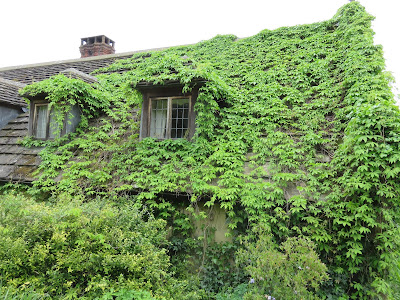After attending the Chelsea Flower Show, I took the train to see Gravetye Manor and Garden, the West Sussex home of garden writer William Robinson. Robinson lived there from 1884 until his death in 1935. He wrote The English Flower Garden and The Wild Garden, both remain relevant to today's gardeners. The Wild Garden was recently re-issued in 2009 with chapters added by the American garden writer, Rick Darke. Robinson was noted for challenging the Victorian fashion of using bedding-out plantings in rigid geometrically-shaped beds. Robinson advocated using native and exotic plants used in a natural way that reflected where they were found in nature. He was inspired by seeing plants in their natural habitats in North America and throughout Europe. The house has been a luxury hotel and restaurant for many years. The gardens are currently being refurbished by Dixter-trained Head Gardener, Tom Coward.
The house looking from the Wildflower Meadow
The entrance to the Flower Garden
A view from across the garden to the same entrance
The opposite veiw from the entance
The Azalea Bank was still in bloom in mid-May
Steps in the Azalea Bank
The Croquet Lawn above the House; the top of the Azalea bank can be seen at the left
A path in the Wild Garden
A handkerchief tree, Davidia involucrata, was in full flower in the Wild Garden.
Camassia in the Wild Garden
The artfully arranged Kitchen Garden was huge
A seat with William Robinson's initials in the Kitchen Garden
This garden, along a wall at the top of the Wild Flower Meadow, had some of the best combinations of plants I saw that day
I am uncertain of the name of the yellow spire in front of the ornamental rhubarb. I am sure it would not be hardy in New Hampshire but it was beautiful.
A pair of cardoons, with a purple-leafed fennel tucked beneath their broad grey foliage, were planted with a grass and the crimson flowers of Cirsium rivulare ‘Atropurpureum’
I have no idea what this plant is (I would welcome an ID) but I thought it had a magnificent presence
The Wildflower Meadow
The bouquet on my table where I had tea
Visiting Gravetye was a sort of pilgrimage for me in my gardening education. There was much that inspired me for my own garden in Peterborough. I was thrilled to finally see it in person. Wave Hill, the public garden in the Bronx, has several gardens (most notably, their "Wild Garden") which are planted in a style reminiscent of Robinson. I think their "Flower Garden" may have also been inspired by the Gravetye Flower Garden. I have studied those gardens for many years. Now I finally see how they were informed by Robinson.
In my own garden, I am interested in both strong design and interesting plantings. Gravetye has both. Gardens worth preserving need a strong and coherent design first and foremost. When the bones are good and well-executed, an old garden almost calls for renewal. This garden has literal bones, i.e. walls, steps, pergolas, and spiritual bones, i.e. the writings of Robinson. It is a garden I hope to revisit on foot and by the fireplace with a book in hand.





















Michael, the yellow spear is Asphodeline lutea which needs good drainage during winter, and the shrub looks to be Callistemon.
ReplyDeleteHi Eric. Nice to hear from you! Thanks for the plant IDs.I saw Asphodeline lutea in several other gardens while I was in England. I didn't see the Callistemon anywhere else...at least I don't think that I did. Hope you are having a good summer. We are having a the beginning of a drought here in NH.
DeleteHi, Michael. I absolutely loved Gravetye Manor when I got to visit it last year.
ReplyDeleteTom Coward is doing some great work there. I think I have photos of exactly the same Asphodeline lutea in my files! It's a plant I've always admired, but would never think of trying to grow.
Hi James. I agree Tom Coward is doing a wonderful job. However, if I thought I could grow Asphodeline lutea, I'd try it in a second.
DeleteWouldn't you just love living at a place like this. I know I would. Jack
ReplyDelete